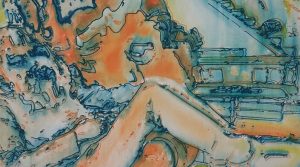Mensch und Maschine
ein kleiner Gedankensplitter
(Man and machine a small fragment of thought)
Showroom
Opening: April 21st, 6 p.m. – 9 p.m.
Duration: 21st April – 26th May
The convergence of man and machine in art refers to the use of technology and artificial intelligence (AI) in artistic practice. There are several ways artists can use human-machine interaction in their work, such as:
Generative Art: Artists can use AI systems to create automatically generated artworks based on a dataset of images, text, or other content.
Interactive Installations: Through the use of sensors and other technologies, artists can create interactive artworks that respond to audience movements and actions.
Robotic Performances: Artists can use robots and other autonomous systems to create unique and fascinating works of art that respond to human interactions.
Virtual Reality: Artists can use VR technology to create immersive artworks that immerse audiences in a virtual world.
The use of technology and AI in art offers artists a whole new level of artistic expression, enabling them to create works of art that are not only aesthetically pleasing, but also address and reflect on social and political issues. The interaction between humans and machines in art also offers an opportunity for viewers to reflect on the role of technology in our society and our understanding of creativity and art.
In fact, Raymond Gantner uses a mix of manual and technical craftsmanship. He combines his own drawings with images from the web, which are traced by a program and by a robot to be brought on canvas. The artist then completes the work manually.
The translation of art by machines is a controversial topic, since art is usually viewed as a human activity, informed by creative, emotional, and aesthetic factors. The idea that machines could translate art raises questions such as whether machines are even capable of understanding art or whether they can only perform algorithmic analysis of artworks.
However, there are different types of machine translation of art. An example is the digital reproduction of artworks through photography or scanning. Technological means are used to store works of art in digital form and make them accessible.
Another type of machine translation of art is the application of artificial intelligence (AI) to the art world. AI systems can be used to analyze and interpret artworks, to identify patterns and trends, or to make recommendations for art lovers or collectors.
Some artists and researchers are also experimenting with using AI systems to create new artworks or enhance existing artworks. This is a form of human-machine collaboration in which the artist directs the creative process, while the machine helps realize the artist’s vision.
Overall, machine translation of art remains an evolving field that continues to be controversial. It remains to be seen how the technology will evolve and what impact it will have on the art world.
Idea: Raymond Gantner
Version: Chat GPT-4
